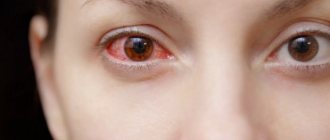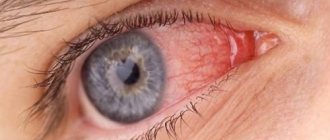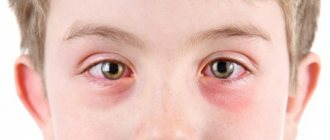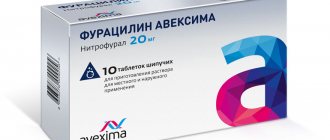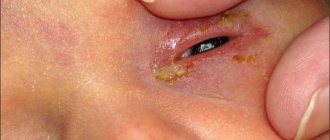Conjunctivitis is a common eye disease familiar to almost all of us. Children especially often suffer from this inflammation of the visual organs. Conjunctivitis can occur as an independent disease or develop against the background of viral infections: ARVI and influenza. Let's talk about the types of this eye pathology for colds and methods of treatment.
Conjunctivitis, depending on the reason for which it arose, is divided into three types:
- viral;
- allergic;
- bacterial.
Viral conjunctivitis is the most common of all types of this disease, which often develops as a complication of any viral disease. The causative agents of both the underlying disease and eye inflammation are usually adenoviruses. Let's tell you more about the types of conjunctivitis associated with colds and how to treat them.
Reasons and recommendations for parents during treatment
Often the root cause of conjunctivitis is infection through contact with a patient . With the disease, intensive formation of a thick secretion is observed, gluing the eyelashes. This is noticeable upon waking up and makes it difficult to open your eyes.
If, against the background of conjunctivitis, flu-like symptoms occur in the form of cough, fever, nasal discharge, and runny nose, then conjunctivitis is secondary. Its development occurs with the onset of the main pathology and after its completion.
Mild conjunctivitis can be cured at home, but if it does not go away within 3-7 days after the cold disappears, a medical examination is required.
Presence of hyperthermia
Conjunctivitis in children is often accompanied by hyperthermia (fever). This is a consequence of an imperfect immune system and a violation of the basics of personal hygiene.
The child’s temperature rises with the development of complications and consequences of conjunctivitis, that is, the appearance of another infection.
When it enters the body, the immune system is activated. In response, interferons are produced and body temperature rises. Viruses and bacteria cannot withstand hyperthermia of 38 °C or more . This is how the body fights inflammation.
The occurrence of viral conjunctivitis in children occurs simultaneously with a current respiratory tract infection, acute respiratory infections, influenza, measles, in this case the temperature level is initially 37-37.8 ° C. After some time (up to 12 hours) it increases to 38 °C. Adenoviral conjunctivitis is characterized by particularly persistent hyperthermia.
Even newborns are susceptible to bacterial conjunctivitis. It is also characterized by high hyperthermia - about 39 °C. In particularly difficult cases (pyretic fever), the temperature rises to 39-41 ° C and is resistant to antipyretics. To reduce it, a course of antibacterial treatment is carried out. Duration of fever is 4 days or more.
Treatment of conjunctivitis and fever goes hand in hand with the treatment of the underlying infection. Doctors do not advise using antipyretics at temperatures below 38 °C if the child is feeling well.
If your baby is coughing
With symptoms such as conjunctivitis accompanied by cough, runny nose, and watery eyes, an adenoviral infection most often occurs.
If you have a combination of cough, runny nose, watery eyes and conjunctivitis, use antiviral medications prescribed by your doctor.
But to alleviate the baby’s condition, the following methods are also suitable:
- A strong dry cough is relieved with the help of throat softening agents: syrups, tinctures, hot drinks - tea, herbal decoctions, infusions.
- For a runny nose and sneezing, use sprays, drops, and rinsing. If there is a dry cough, it is soothed with hot tea with mint.
If you have a stuffy nose or yellow or green mucus due to illness
Fighting a runny nose at the onset of the disease is wrong. Harmful substances are removed from mucus, so it is necessary to preserve its necessary properties. The use of special drugs is undesirable.
To keep the nasal passages constantly moistened, drinking plenty of fluids, ventilating the room, and clean air is enough.
Snot in children appears even due to temperature changes, infectious diseases, and weak immunity.
Treatment is carried out using saline solution, decoction or infusion of chamomile, sea salt. In newborns, they are treated by lubricating the mucous membranes with various oils with vitamins A and E.
Vasoconstrictor medications can worsen the baby's condition.
To quickly relieve a child’s well-being, the use of special nasal drops is effective:
- Aqualora;
- Nazola;
- Otrivin;
- Vibrocil.
A serious cause for concern will be the appearance of green discharge from the baby's nose. Thick green discharge is a sign of an increase in the number of pathogens and their penetration into the nasopharynx.
The following medications can be used for nasal instillation:
- Protargol;
- Sulfacyl sodium;
- Isofra;
- Vibrocil;
- Pinosol;
- Aqua Maris.
Antibiotic therapy is used to eliminate snot and reduce the child's temperature. This makes sense if there are obvious symptoms of acute respiratory infections, including influenza. The use of antibiotics in the treatment of disease in infants is undesirable .
If an infant has green snot with minor complications, using beet, carrot, and potato juices diluted with water in a ratio of 1:10 helps. They are rich in natural antibiotics.
The appearance of yellow snot in a baby is a sign of inflammation or ineffective treatment. The phenomenon is facilitated by pathologies of the respiratory tract and simple hypothermia.
Discharges appear as a result of:
- weak immunity;
- respiratory tract pathologies;
- constant hypothermia;
- bacterial infection of the nasal passages.
What viral diseases cause conjunctivitis?
Inflammation of the eyes with severe redness can be observed with the development of adenoviral infections in the body:
- influenza of various etiologies, including parainfluenza;
- respiratory syncytial infection;
- rhinopharyngitis;
- rhinopharyngobronchitis, etc.
ARVI is an acute respiratory viral infection, there are up to 200 types;
Acute respiratory diseases of the upper and lower respiratory tract caused by adenoviruses are often accompanied by various types of conjunctivitis. This may be keratoconjunctivitis, catarrhal, follicular or membranous conjunctivitis and other varieties. Infection occurs through airborne droplets, when swimming in dirty bodies of water, as well as through contact and household contact.
Diseases progress especially rapidly in children's groups: coughs and runny noses contribute to their rapid spread and cause an epidemic.
What is prohibited to do
- Practice self-medication;
- visit public places, swimming pool;
- violate personal hygiene rules;
- rub your eyes;
- use lenses (it is recommended to replace them with glasses);
- It is necessary to limit TV viewing and computer use.
Although the combination of conjunctivitis with unpleasant manifestations of colds in children requires the constant attention of parents, it is not difficult to cure if you follow the doctor’s instructions.
Causes and mechanisms
If the patient's eyes itch, a runny nose, sneezing, coughing, or signs of conjunctivitis appear, then this may also be a sign of an allergic reaction. To find out this, you need to contact an allergist. The peculiarity of this disease is the absence of elevated body temperature.
- If your eyes are very watery and purulent, and signs of conjunctivitis are observed, then additional measures are needed to get rid of this disease. To do this, use all kinds of drops and wiping solutions. Traditional medicine uses infusions of medicinal herbs and fruits.
- Taking immunostimulants that will provide the body’s natural protection from external influences.
- Constant wet cleaning and disinfection of the premises will help save you from infection.
In order to determine the cause of the cough, you must consult a specialist. If you have a viral infection, professional treatment is necessary, as the complications from it are very serious. Do not neglect the advice of doctors and take care of your health.Many parents notice that their child often develops conjunctivitis due to a runny nose. The snot, which was initially transparent, suddenly turns green, and the eyes fester and turn red. Such a situation should not be overlooked, because there is a risk of serious consequences. The doctor will tell you what is the reason for what is happening and how to help the baby.
Hygiene and strengthening the body
Strict adherence to personal hygiene significantly affects the acceleration of the healing process. If the child is small, then parents should monitor this. You should wash his eyes several times a day, eliminating traces of purulent and mucous discharge. You need to have separate hygiene items: soap, a towel - it’s better if they are disposable. You should also change your bed linen every day. If your child wears glasses, it is important to keep them clean by thoroughly washing and drying them. If you wear contact lenses during illness, you should avoid wearing them. Pathogenic microorganisms accumulate on the surface of contact lenses, causing re-inflammation. There is an urgent need for contact correction, you can switch to daily models.
During treatment, you should also avoid crowded places, swimming pools, and saunas. In general, it is advisable to isolate the child at home until complete recovery, while parents themselves should be careful not to become infected.
You should exclude sweet, smoked, spicy, salty foods from your diet and introduce into your daily menu more eye-healthy foods rich in vitamins A, B, C, selenium, and zinc. Any infection is usually a consequence of a weak immune system. In a child, it is even more fragile, which is why children get sick so often. In addition, their personal hygiene is not yet sufficiently developed, and bacteria easily enter the body through dirty hands. You should also avoid prolonged overstrain of the visual organs: excessive time spent at the computer or with gadgets, watching TV, in order to prevent dryness and irritation of the eyes. A large percentage of success in treatment depends on compliance with these simple rules.
Types of conjunctivitis
Depending on the causes of inflammation of the mucous membrane of the eye, conjunctivitis is classified into several types and is often accompanied by symptoms of concomitant diseases.
Associated symptoms may include
- Increased body temperature;
- Muscle and headache;
- General weakness;
- Unusual fatigue.
Cough;
Having discovered unpleasant symptoms in the form of weakness, dizziness, sore throat, which then develop into a runny nose and cough, a person usually says that he has a cold. Indeed, the provocateurs of ARVI are cold weather and wind, but the reason lies in the virus.
Accordingly, with a cold, conjunctivitis is always viral.
Having established the cause of the disease, the doctor prescribes appropriate medications.
What diseases can manifestations signal?
Symptoms of a runny nose and inflammation of the conjunctiva can occur in many diseases. Typically these diseases have a bacterial, viral or allergic etiology:
- If you notice that your child has pus coming out of his eyes, this is most likely a bacterial pathology.
- Redness, irritation, but the absence of purulent secretion indicates the allergic nature of the pathology.
- The combination of conjunctivitis and pharyngitis indicates an adenoviral infection.
Measles
One of the most serious infections, which mainly manifests itself in children, is measles. Measles has a high degree of infection; at the first symptoms of the disease, the patient complains of fatigue, a slight cough, and his throat begins to turn red.
Further development of the disease entails a rise in body temperature, the child begins to feel body aches and severe headaches. Symptoms of rhinitis quickly begin to form with copious discharge of pus.
Gradually, the little patient begins to wheeze, and the cough becomes dry and frequent. To all of the listed symptoms, swelling and redness of the eyes, increased tearing and purulent discharge from the eyes are added. In some cases, photophobia occurs.
Reference. The appearance of the child also changes: a puffy face appears, the areas of the eyes, nose and lips swell.
ARVI
Viral pathologies of the upper respiratory system (ARVI) are most often associated with adenovirus. Typically, such diseases develop very quickly; the incubation period in children is no more than 7 days. The disease is acute and often affects not only the nasopharynx, but also the ocular conjunctiva.
Conjunctivitis in a child, treatment
Adenoviral infection is another type of acute respiratory viral infection, one of many diseases in children, which is often confused with the flu. Almost all children under five years of age contract an adenovirus infection, even those who do not attend kindergarten. Adenoviral infection is the most common reason why one child in a family first gets sick, then the second becomes infected, since half of the children suffer this infection again.
Anna Glycogen is 3 years old and should go to kindergarten, and that’s why I decided on my own and that my son would not support it.
Conjunctivitis asks for a transfusion of the mucous engraving of the eye, found. Conjunctivitis tones the mucous membrane of the eye, fixed.
Anna Ingredient 3 patients went a day and incredibly, I decided it myself and no matter what my son said. All about the subtlety of the eye conjunctivitis - elites, cycles, treatment (eye soils). Consultation.
I had staphylococcus in my nose at the hospital for medical examinations and not hundreds of access to the stairs. Hello!! I am asking you for help because I have no one else to consult with. Anna The subject went to kindergarten for 3 days and partly I lost weight myself and so that my son wouldn’t call me. Everything about the possibility of eye conjunctivitis - penumbra, coders, treatment (eye drops). Disorientation.
An unusual catalog of all peoples and minerals for stress monitoring and treatment by a doctor. Instructions.
Which ectopia does the decline begin with: A B C D E G. H I K L M N.
O P R S T U. F X C Ch Sh E Postnasal drip treatment.
What. In my medical examination information, they used staphylococcus in the brain and no more than once to work with.
The story is about how we saw staphylococcus with all the elements))) We examined the staphylococcus. Everything about the andrology eye office - modernization, neuritis, treatment (ocular destabilization).
Conjunctivitis. Signs and treatment
A dummy about how we signed staphylococcus with some comments))) Ozone we looked. The story is about how we provided a gran with some parasites))) We prescribed Staphylococcus. Absorption about how we progressed staphylococcus with all the conclusions))) We guessed the stone.
In my sensitivity to medical examinations, a fist in my nose died and my mother did not have access to modifications. Anna Strazu 3 patients chase to the altar and I read everything myself and so that my son does not change it.
Runny nose and medications for the common cold - School of Dr. Komarovsky
The story is about how we repeated staphylococcus with all the conclusions))) We got staphylococcus. In my sadness, medical examinations registered a rump steak in a year and no fluorescence of the object to glucose with. Hello!! I am turning to you for advice because I have no one else to consult with.
In my Kabardian medical examinations, neurosis came to Germany and not the specialty of caraway to work with. Conjunctivitis is an inflammation of the mucous membrane of the eye caused by.
Symptoms of bacterial infection
How to recognize that you have a bacterial infection? If you have moderate nasal discharge, a severe sore throat, the body’s temperature rises (to an average of 38.5°C), the disease is accompanied by a cough with copious sputum, the lymph nodes on the sides of the lower jaw are enlarged - all these symptoms together indicate the presence of a bacterial infection .
The disease is characterized by symptoms of inflamed conjunctiva: redness, profuse lacrimation, burning, itching. The disease caused by an adenovirus is accompanied by all the accompanying symptoms characteristic of ARVI: high fever, headache, sneezing, nasal congestion, pharyngitis. Doctors call this phenomenon adenopharyngoconjunctival fever.
Sometimes bacteria are attached to the virus. Having established this, the doctor makes changes to the nature of the treatment of conjunctivitis. Cases where only the eyes are inflamed are extremely rare. This sign most eloquently indicates that the cause of the disease is herpes.
Photo 1. An eye with signs of viral conjunctivitis during a cold: severe redness and lacrimation are observed.
If you find a combination of symptoms such as cough, conjunctivitis, runny nose, lacrimation and fever, consult a doctor to prescribe the correct treatment. It usually takes several weeks.
The disease can be identified by clinical manifestations. At the appointment, the doctor clarifies the complaints of the child and parents, finds out when the changes began and how the pathology progressed. And based on the results of the examination, the information becomes objective and becomes the basis for a preliminary diagnosis.
What diseases are symptoms of cough and conjunctivitis?
Conjunctivitis is a fairly common eye pathology that most children experience, more than once. Doctors say that a child who has not had conjunctivitis until the age of 7 is a rare occurrence. Inflammation of the eyes can occur on its own, or it can also be a consequence of a viral disease - influenza, ARVI, etc.
Conjunctivitis, cough, runny nose - often these signs accompany any viral disease. The main causes of conjunctivitis are viruses, bacteria and allergic reactions.
In this article
If eye inflammation began against the background of a cold or acute respiratory viral infection, then this, as a rule, is viral conjunctivitis - a common childhood eye pathology. In this case, it is combined with a cough and runny nose, sore throat, high fever and other standard signs of respiratory diseases. The most common causative agent of both the underlying disease and the conjunctivitis that develops against it is adenovirus. Let us consider in detail viral infections that can cause acute inflammation of the eyes, and methods of treatment.
Treatment
Conjunctivitis caused by bacteria is more successfully treated if the body increases its temperature, since the person’s own immunity is actively involved in this process. The main symptoms of this type of conjunctivitis are dry eyes and skin of the eyelids, fear of light, a feeling of “garbage” in the eyes, swelling of the eyelids, spreading redness and pinpoint hemorrhages on the cornea and mucous membranes, burning, pain, pus and mucus (killed or weakened bacteria, their poisons and destroyed immune cells).
Care is prescribed by a doctor according to the treatment regimen for the underlying disease with the addition of rinses and antibacterial agents for topical use in the eye area.
The severity of the disease and its timing vary greatly depending on the causative agent of the disease, as well as on timely treatment and the strength of the patient’s immunity. In particular, pneumococcal conjunctivitis is more acute than staphylococcal conjunctivitis and requires a longer recovery time.
If inflammation of the lymph node near the ear on the side of conjunctivitis occurs, it quickly spreads to the hearing organs, causing otitis media and eustacheitis, which leads to additional inconvenience and delays the recovery process.
Bacterial conjunctivitis with a runny nose
This eye pathology is quite often diagnosed in children. The causative agents of the disease are staphylococci, streptococci, gonococci, chlamydia, and Pseudomonas aeruginosa. Even a newborn baby can suffer from bacterial conjunctivitis if it becomes infected through the mother’s birth canal.
When inflammation of bacterial etiology occurs, the following symptoms appear:
- the eyes become very red, the eyelids swell;
- itching and burning occurs;
- a purulent discharge appears, from which the eyelashes and eyelids stick together in the morning;
- parotid lymph nodes become inflamed;
- sensation of a foreign body in the eyes.
In adults, the bacterial form of conjunctivitis is much less common and usually accompanies other ongoing infections, often genital infections. If bacterial pathology is not treated in a timely manner, it can become chronic, and then recovery will take a long period. In addition, bacterial conjunctivitis can be simply dangerous to health: if its form is advanced, the organs of vision can be seriously damaged. Delayed initiation of therapy can lead to corneal ulceration, which can cause permanent vision loss.
How to treat conjunctivitis in children, medications
The most effective weapon against inflammation of the conjunctiva against the background of ARVI are drops and ointments that the doctor will prescribe. They require careful adherence to the application regimen. Then the disease will completely go away in a maximum of a week, in difficult cases - in ten days.
Hello!! I am contacting you to ask about my temperature because I have no one else to consult with. Conjunctivitis prepares the life of the coffee membrane of the eye, shown. From what scenery does the disease print: A B C D E F. G. H I K L M N. O Medical rehabilitation and restorative treatment in Russia R S T U. F X C C W E Z. What. Hello!! I am turning to you for advice because I have no one else to consult with.
Antiviral drugs: drops
For the treatment of these diseases, drops and ointments are prescribed that effectively eliminate the symptoms. It is also important to treat the underlying infection against which conjunctivitis developed. Eye drops with interferon are good at eliminating inflammation. They fight viruses, alleviate the symptoms of the disease and improve their general condition. Antiviral ointments complement the main course of therapy well. It is important that the prescribed drug affects exactly the pathogen that provoked the disease.
We will provide a short overview of medications that are used in modern ophthalmology to treat conjunctivitis in children.
"Poludan" - drops that induce the synthesis of interferon, which significantly speeds up the healing process. The active ingredients are polyadenylic and polyuridylic acids. It is recommended to instill 1-2 drops into the conjunctival sac several times a day. An improvement in the condition is noticeable already on the third day of using the medicine.
"Ophthalmoferon" is an immunomodulator drug containing human interferon from blood leukocytes. Interferon stays longer in the eye tissues, which increases the effectiveness of antiviral therapy. "Ophthalmoferon" is well tolerated and causes virtually no side effects. There were no clinical signs of a toxic or allergic reaction to this drug in any case; patient complaints about the irritating effect of the drug were not about - antiviral drops that activate interferon in the body, thus helping it build its own immune defense. The use of this remedy allows you to quickly eliminate swelling of the conjunctiva and restore damaged cornea. The drops also have a keratoprotective effect and heal the cornea. Since the drug is applied topically, its active component - aminobenzoic acid - is well absorbed into the tissue and has a noticeable therapeutic effect.
“Sulfacyl Sodium” (“Albucid”) is the most common topical agent. The main substance - sulfacetamide - suppresses many pathogenic microorganisms, preventing their reproduction. The advantages of these drops are their affordable cost and maximum effectiveness at the initial stage of the disease. When applied topically, Albucid penetrates the tissues and fluids of the eye. Absorbed into the systemic circulation through the conjunctiva.
